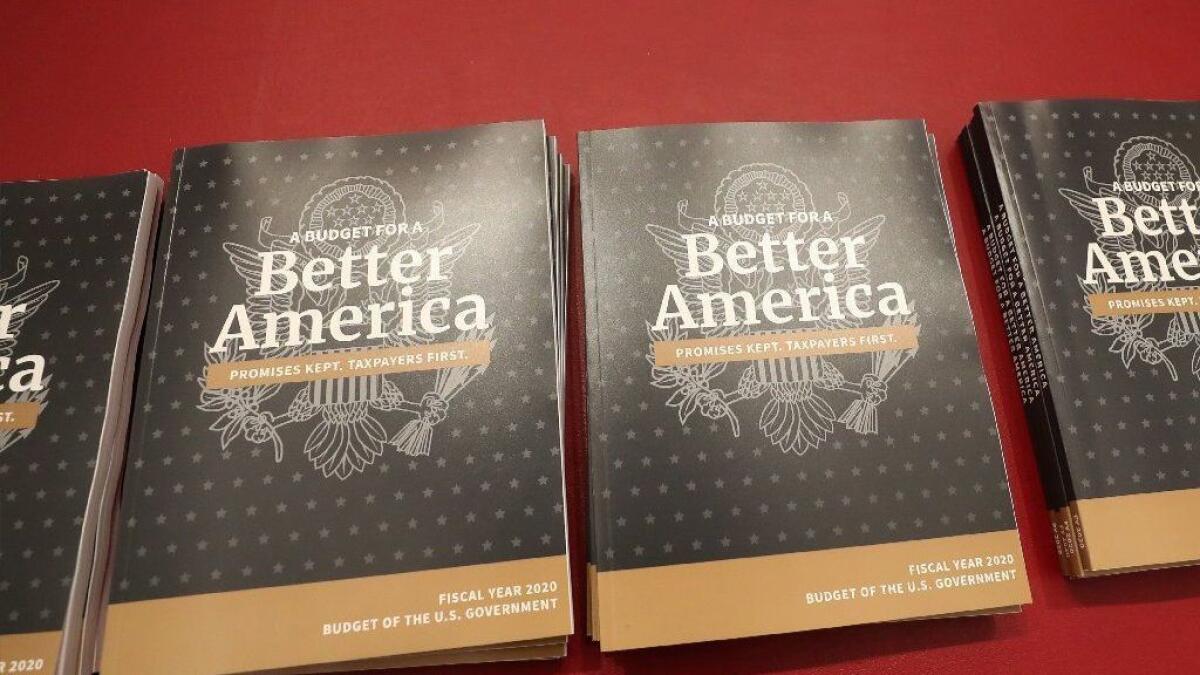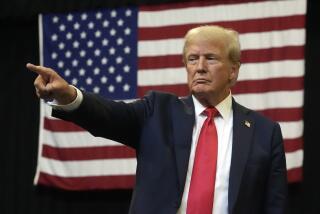For a president who doesn’t sweat details, a new $4.7-trillion budget gets short shrift

The new budget request that President Trump sent to Congress on Monday confirmed his intention to keep up his multibillion-dollar fight for a southern border wall.
His budget for the fiscal year that begins in October calls for $8.6 billion in new funds for a barrier along the border with Mexico, beyond the $6.7 billion Trump has said he plans to spend in coming months under the national emergency he declared to circumvent Congress for the money.
The $4.7-trillion budget he sent Congress would make another steep increase in Department of Defense spending — by 5%, to a total of $718 billion — while slashing domestic spending programs by an equal percentage. The president once again pushed back his promise to eliminate the annual deficit, this time until the mid-2030s. Starting this year, deficits return to the trillion-dollar levels of the global economic crisis of a decade ago.
Yet the budget, and the few details that leaked before its release, were greeted mostly by shrugs — not least by the president himself.
While past presidents used the release of their annual spending plans as an opportunity to lay out short- and long-term visions, and to influence subsequent negotiations on Capitol Hill, Trump has taken the lack of regard for budgets to new lows, reflecting his own lack of interest in policy details, his administration’s thin staffing and its overall ambivalence about the nitty-gritty of policy-making.
White House spending plans typically have been considered dead on arrival in Congress. Rep. John Yarmuth, the Kentucky Democrat who leads the House Budget Committee, said Trump’s budget “has no chance in the House.” His Republican counterpart in the Senate, Sen. Michael B. Enzi of Wyoming, put it more diplomatically, calling Trump’s budget “the first step in the federal budget process” that “will allow us to consider how his priorities align with the priorities of Congress.”
In the past, despite talk of presidents’ budgets being DOA, their individual details and policies loomed large as Congress turned to exercising its constitutional power of the purse. For Trump’s budgets, that has been increasingly less true.
“I don’t think the president feels that he has to focus on the budget,” said G. William Hoagland, a former longtime budget advisor for Senate Republicans.
“They can’t decide what their goals are with the federal budget,” Hoagland, the senior vice president for the Bipartisan Policy Center, said of the administration. “Do they want to reduce the deficit? I just don’t think there’s any thoughtful process that’s going on, other than to cut taxes and muddle through.”
His top domestic policy plans other than the border wall — rebuilding the national infrastructure and reducing prescription drug prices — are alive in Congress, but the president has yet to use his ability to garner media attention to put much of a spotlight on them and help push them into law.
Also, the budget provisions for both initiatives are more modest than Trump’s rhetoric would suggest.
The budget includes policy suggestions to speed and increase the availability of less expensive generic drugs. For infrastructure, the $200 billion the administration touts is a 10-year figure; just $5 billion of that would be spent in the coming year — an amount smaller than Trump seeks for the border wall. The full $200 billion is the same amount that the president has unsuccessfully sought before, and well short of the $1 trillion he promised as a candidate.
A senior administration official who briefed reporters on the condition that he not be named said that the infrastructure proposal, once leveraged for private investments, would lead to $1 trillion in total spending. The official offered no details, and conceded that the proposal has “less specifics this year than we have in the past” because “we really do want to work with Congress on this.”
The budget also calls for reducing Medicare spending by $846 billion over the next decade, a significant cut for a president who vowed to keep Medicare spending whole during his campaign. It cuts another $327 billion from safety net programs, including Medicaid, housing and the nutrition benefit known as food stamps. The nutrition savings would come from new work requirements on beneficiaries. Also targeted for cuts are federal student loans.
The details provided instant fodder for Democrats, who signaled they plan to use them against him as he seeks reelection.
Sen. Kamala Harris, the San Francisco Democrat who is running for president, tweeted: “This budget says a lot about the president’s priorities: cut $845 billion from Medicare, while spending billions on his vanity project, the wall. This would hurt our seniors and is yet another piece of evidence for why we need a new president.”
House Speaker Nancy Pelosi (D-San Francisco), using 10-year figures, said in a statement: “After adding $2 trillion to the deficit with the GOP tax scam for the rich, President Trump wants to ransack as much as $2 trillion from Medicare and Medicaid. While demanding billions more for his wasteful, ineffective wall, President Trump will steal from students and hungry families, from rural communities and American farmers, from clean air and clean water, and from vital, job-creating investments nationwide.”
Trump had resisted reducing projected Medicare spending in the past. But his acting chief of staff, Mick Mulvaney, who was aligned with the tea party movement when he served in Congress, has advocated changes that he said can be made without cutting recipients’ benefits. Trump’s budget director, Russell Vought, told reporters that Medicare savings would come from drug-price changes and unspecified steps to reduce “waste and fraud.”
Neither party is interested in addressing spending for the so-called entitlement programs — Medicare, Medicaid and Social Security — whose costs are increasing with the retirement of the large generation of baby boomers. The programs are the major driver, along with reduced tax collections, of the projected growth in annual deficits and the accumulated debt.
That long-projected growth in those benefit programs, along with Trump’s tax cuts and military spending increases, has put annual deficit projections back over the $1-trillion level last reached at the height of the global recession as President George W. Bush left office.
Trump’s budget projects a deficit for the current fiscal year of nearly $1.1 trillion — from $779 billion last year and $587 billion in President Obama’s last year — and just over $1.1 trillion in fiscal 2020, as he seeks reelection. The deficit has risen to about 5% when measured as a share of the overall economy; economists generally consider 3% the preferred limit.
To help hold down the size of projected deficits, the administration’s overall economic forecasts are optimistic and out of line with most other estimates, including from the Federal Reserve and corporate analysts.
The White House predicts the economy will grow 3.2% this year and expand at a rate of 3% or higher every year through 2024. U.S. economic growth was 2.9% in 2018, just under the administration’s 3% estimate in the budget released last year.
Most analysts expect growth to slow this year as the stimulus of the tax cuts wears off and the global economy ratchets back. The Fed in December forecast 2.3% U.S. growth this year, declining to 2% in 2020, when many economists say a recession could hit. The Fed’s estimates are roughly in line with those from the International Monetary Fund in January.
Trump continues to propose deep cuts for the State Department; past reductions have caused widespread morale problems. The proposed $40-billion budget, which reflects a reduction of about 20%, gives priority to protecting U.S. personnel overseas, Israel and other allies in the Middle East. It would slash foreign aid and money for international organizations.
Trump was active on Twitter over the weekend, yet avoided any mention of his spending plans. Unlike prior presidents, who spent weeks previewing top agenda items, including in their State of the Union addresses and community visits beyond Washington, he did not follow his televised speech to a joint session of Congress last month with a sustained policy pitch and has no plans to travel to promote the budget this week as predecessors did.
The president, who is known to cut off and lose confidence in advisors who try to engage him in lengthy policy discussions, was little involved in the budget process. His current budget chief, Vought, has been serving on an acting basis only since January after Mulvaney left the job to become Trump’s acting chief of staff.
Trump’s predecessors, to varying levels, tended to show more interest in the details. Even President Reagan, while known to prefer the big picture, had spent time on budgets as governor of California before taking office and, as president, was fully briefed. Presidents Clinton and Obama, known to obsess over the small stuff, worked closely with senior advisors during budget season.
“The first budget we did, he was there for almost the entire discussion, which I thought was unusual, but that’s what he wanted to do,” said Leon Panetta, who served as Clinton’s first director of the Office of Management and Budget.
Panetta said a rigorous process not only helps develop a sales pitch to Congress and the public, but also pushes the White House staff to debate their policies internally.
“What I’m seeing now is that it’s kind of a scramble to put together any kind of budget,” he said. “I get the impression that there’s kind of this approach that the budget is DOA, what difference does it make?”
Times staff writers Tracy Wilkinson and Jim Puzzanghera contributed to this report.
Follow the latest news of the Trump administration on Essential Washington »
More to Read
Get the L.A. Times Politics newsletter
Deeply reported insights into legislation, politics and policy from Sacramento, Washington and beyond. In your inbox three times per week.
You may occasionally receive promotional content from the Los Angeles Times.











